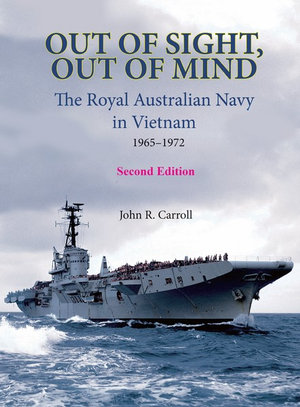- Author
- Book reviewer
- Subjects
- Ship histories and stories, Book reviews, Post WWII
- Tags
-
- RAN Ships
- HMAS Jeparit, HMAS Bonthorpe, HMAS Sydney II
- Publication
- March 2020 edition of the Naval Historical Review (all rights reserved)
Out of Sight, Out of Mind: The Royal Australian Navy in Vietnam 1965-1972. Second Edition. By John R. Carroll. First published in 2013, this second edition has been revised with new material added. This folio sized softcover volume of 258 pages with illustrations and photographs was published by Rosenberg, Sydney in January 2020 at rrp of $34.95.

During the Vietnam War the task of moving, supplying and maintaining the Australian Force in Vietnam was crucial. The RAN played the major role and did the heavy lifting for these logistic tasks. The principal effort was undertaken by the fast troop transport and former aircraft carrier HMAS Sydney, which was always escorted in Vietnamese waters by an RAN destroyer or frigate from the Far East Strategic Reserve.
Captain A. J. Robertson DSC, later Rear Admiral, quoting from the commanding officer’s letter to his Flag Officer (FOCAF) noted: ‘From 1965 until March 1972 HMAS Sydney completed 24 voyages to the operational area, transporting troops and large quantities of important equipment. 15,619 troops were carried, 8,129 taken to South Vietnam and 7,490 brought back to Australia. 2,301 vehicles were carried, 1,523 on the forward journey and 778 on the return. Short tonnage cargo totalled 5,561 with 4,289 for South Vietnam and 1,272 returned. Whilst in Vietnamese waters, she was subject to the same threat as other Fleet units, particularly rocket or swimmer attacks in Vung Tau harbour’. There is no doubt that Sydney was the logistical lynchpin for the Australian military effort in Vietnam. Sydney was assisted in the sealift requirement by MV, later HMAS, Jeparit and MV, later HMAS, Boonaroo.
Complement details of Sydney during each of her voyages to Vietnam are tabulated as well as anchorage details of the ship and her escorts. Security precautions whilst in Vung Tau are presented. There is a chapter with candid comments from the author’s shipmates as well as embarked troops.
In his well-written and superbly researched book Dr Carroll offers evidence-based arguments regarding the critical role of the RAN. Furthermore, he presents compelling evidence that RAN personnel in Sydney were affected by the runoff from the liberal use of the toxic Agent Orange and its active and toxic by-product Dioxin. He further addresses the inequity suffered by RAN personnel towards provision of medical care under the repatriation system. There was also inequity for awards under the Honours and Awards system, particularly in respect to the Vietnam Active Service Medal. All this revolved around the interpretation of the word ‘allotted’. Soldiers were eligible for the above benefits because they had been allotted a role with their battalion whilst in Vietnam. On the other hand seamen were not allotted a role but were among the ship’s company which did not necessarily set foot on Vietnamese soil. Hence the discrimination or inequity.
From January 1962 the US and Allied forces used herbicides to strip the thick jungle canopy which helped to conceal the enemy. Crops would also be damaged. Sydney and her escorts were often at anchor in Vung Tau harbour in waters now known to be contaminated with herbicide residue. By the time Sydney and the first army contingent arrived at Vung Tau in June 1965 the Rung Sat Special Zone (RSSZ) had been sprayed by the USAF since September 1962.
In 1997 the Department of Veterans Affairs reported that RAN veterans were experiencing a far higher mortality rate than other Australian Vietnam veterans, particularly RAN logistic support personnel. This was further supported by the 2001 Vietnam Veterans Cohort Study where it was noted that sailors from Sydney and her escorts as well as those from Jeparit and Boonaroo were dying at a rate which was higher than the national average.
Carroll provides a chapter on herbicide exposure. This chapter argues a likely link between the mortality rate of RAN logistic support personnel exposed to the evaporative distillation used in RAN ships while in Vietnamese waters which was enhanced by the effects of Agent Orange. The author also addresses the issues and responsibilities of Government agencies in regard to the singularly crucial use of the word ‘allotted’. CDRE John Goble stated ‘no one allotted the RAN elements. There is no doubt that all servicemen were at risk by being in an operational area’.
The substance of the book was the basis for Dr John Carroll’s PhD thesis – as such it is of an extremely high standard. There is a foreword by VADM I. W. Knox AC, previously Vice Chief of Defence Force, who commends the work for those interested in maritime affairs and logistical support of Australian forces in Vietnam. The book will long stand as a key reference point to the RAN contribution in Vietnam and, as such, will not be ‘Out of Sight’ nor ‘Out of Mind’.
Reviewed by Kevin Rickard




